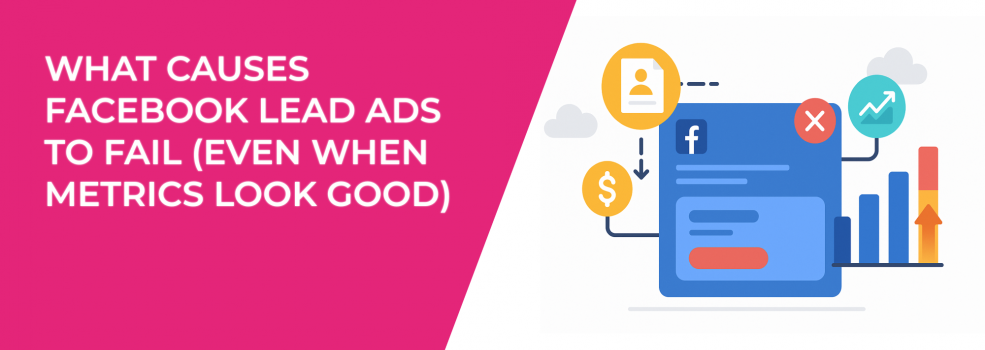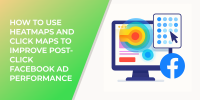Facebook Lead Ads can feel like a marketer’s dream. Low cost per lead, easy form fills, and a seamless user experience — all without leaving the platform. On paper, it looks like a win. Your dashboard shows high CTRs and impressive lead volumes. CPL is within target. But then… nothing.
Sales don't increase. Qualified appointments remain stagnant. Your CRM is full, yet conversions lag behind.
Why do campaigns that appear to be successful on the surface often fail to deliver where it matters most in actual business growth?
Let’s break down the real reasons Facebook Lead Ads underperform, even when the metrics look promising, and how to course-correct before more budget goes to waste.
1. High Lead Volume Does Not Equal High Lead Quality
One of the most common pitfalls of Facebook Lead Ads is their inherent ease of use. Users can submit a form with just a few taps — often without fully understanding what they’ve signed up for. That low barrier to entry, while beneficial for generating volume, often results in poor lead quality.
Why this happens:
-
Facebook pre-fills form fields using profile data.
-
There is minimal friction, reducing the need for users to think critically before submitting.
-
Users can accidentally complete forms without genuine interest or intent.
Strategies to address it:
-
Add friction intentionally. Use conditional logic or multiple-choice questions that require the lead to make an informed choice.
-
Ask intent-revealing questions. For example: “When are you planning to make a purchase?” or “What is your biggest challenge right now?”
-
Use click-to-site campaigns with landing pages when higher qualification is needed. This forces users to make a conscious decision to engage.
Pro tip: use Facebook’s “Higher Intent” form setting. It includes a review screen before submission, which can reduce accidental or low-intent completions.
To improve not just the number but the quality of your submissions, make sure you're following these best practices for optimizing Facebook Lead Ads for higher conversion rates.
2. Over-Reliance on Weak or Outdated Targeting
Facebook's targeting landscape has changed significantly due to privacy policies, cookie limitations, and the platform’s algorithmic shifts. As a result, advertisers relying solely on interest-based or lookalike targeting are often working with outdated signals.
What this looks like:
-
Audience segments built on vague interests (e.g., “business” or “marketing”) may attract users outside your ideal buyer profile.
-
Lookalike audiences based on past converters may no longer reflect purchasing behavior, especially if your pixel data is shallow.
Advanced targeting strategies:
-
Use custom audiences derived from first-party data. Upload email lists of past buyers, high-value leads, or newsletter subscribers.
-
Leverage engagement-based audiences. Create segments of users who interacted with videos, carousels, or Instant Experience ads.
-
Test exclusion targeting. Remove audiences that have already converted, bounced from your site, or engaged without converting — to reduce wasted impressions.
-
Combine behavioral and contextual signals. Pair audience targeting with time-based triggers (e.g., retargeting during active sales periods).
If your current targeting setup feels outdated or ineffective, revisit the fundamentals in our complete guide to Facebook ad targeting.
3. Misaligned Ad Creative and Messaging
Your ad sets the expectation. If that expectation doesn’t align with the experience post-click, drop-off is inevitable.
Vague CTAs like “Get Started” or “Download Now” might drive clicks, but they don’t clarify what the user will get or why they should care. Worse, if the lead magnet or offer lacks perceived value, the lead’s motivation to respond to follow-up outreach plummets.
How to fix it:
-
Be specific in your value proposition. Instead of “Book a free consultation,” try “Schedule a 20-minute call to receive a personalized action plan.”
-
Align ad copy, form copy, and follow-up messaging. Ensure consistency between what the user sees in the ad and what they experience after converting.
-
Use visuals that reflect the offer. If the ad is promoting a downloadable guide, show a mockup of the asset. Avoid generic stock images.
-
Split test your creative elements. Test different headlines, CTA buttons, and descriptions to identify which combinations drive not only leads but sales-ready leads.
Example: a SaaS company running lead ads for a demo should avoid messaging like “See How It Works” and instead use “Get a Custom Walkthrough of How [Product] Solves [Problem].”
Strong copy isn’t optional — it’s essential. Learn how to craft Facebook ad copy that converts with real examples and best practices.
4. Delayed or Impersonal Follow-Up
Speed matters. According to multiple studies, contacting a lead within five minutes significantly increases the chances of conversion. Yet many businesses wait hours — or even days — to respond. Others rely on one-off emails that lack personalization and fail to build trust.
Why follow-up fails:
-
Slow response times due to lack of automation or staff.
-
Inconsistent messaging between marketing and sales teams.
-
Generic emails that feel templated or irrelevant.
Actionable improvements:
-
Automate initial touchpoints. Use CRM tools to send instant email or SMS confirmations within minutes of lead submission.
-
Create multi-channel workflows. Follow up via email, SMS, and phone to increase engagement rates.
-
Assign leads based on criteria. Route high-intent leads directly to sales reps, while nurturing colder leads through marketing automation.
-
Use progressive profiling. Continue to learn more about the lead with each interaction, and tailor future communication accordingly.
Pro tip: personalization isn’t just about inserting a first name. Reference the specific offer they signed up for, their industry, or any pain point they shared in the form.
Want to strengthen your follow-up system? Learn how to combine Facebook Lead Ads with email marketing to improve engagement and lead quality.
5. Lack of a Lead Nurturing Strategy
Most leads are not ready to buy immediately. Yet many advertisers treat every lead as sales-ready and give up when there's no quick win. This short-term mindset leaves a massive amount of revenue untapped.
Why nurturing matters:
-
Only 10–20% of leads are typically ready to buy within the first 30 days.
-
Leads who aren’t nurtured forget who you are — or worse, buy from a competitor who stayed top of mind.
-
Long-term nurture flows can increase close rates by 20–40%, depending on the industry.
What a good lead nurturing strategy includes:
-
Email drip sequences tailored to the user’s stage of awareness or funnel position.
-
Behavior-triggered campaigns — for example, sending different follow-ups based on whether a lead visited a pricing page or downloaded another asset.
-
Content that educates and adds value. Don’t just sell. Share customer stories, product walkthroughs, use cases, and market insights.
-
Retargeting ads that reinforce your offer or invite users to take the next step (e.g., schedule a call or attend a webinar).
Pro tip: track engagement signals like email opens, link clicks, or site visits to score leads. Use lead scoring to prioritize who gets sales outreach and who stays in nurture.
Lead nurturing is just one part of the equation. Explore top lead generation strategies for 2025 to future-proof your funnel.
Final Thoughts
Facebook Lead Ads are powerful, but they’re not magic. When they fail, it's rarely because of the ad format itself. More often, the issue lies in what happens before and after the lead is captured.
Strong campaigns require:
-
Precise targeting based on real data.
-
Messaging that clearly communicates value.
-
Immediate and personalized follow-up.
-
Nurture strategies that convert long-term interest into real business results.
Metrics like CTR and CPL only tell part of the story. If your campaigns look good in the dashboard but aren’t delivering real pipeline growth, it’s time to look deeper.
Ask yourself:
-
Are my leads truly qualified?
-
Is my targeting based on behavior or assumptions?
-
Does my follow-up match the promise of the ad?
-
Am I supporting long-term conversions — or just chasing short-term volume?
The answers to those questions can reveal more than any ad report.

